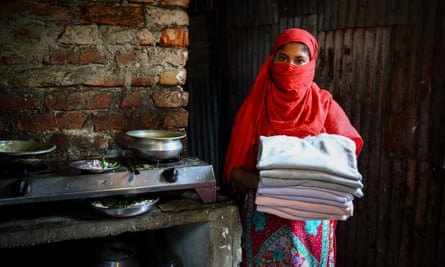Just four cents from every dollar Australians spend on clothing makes it back to workers enduring “horrific” conditions in garment factories, a new report has found.
The report adds to pressure on Australia’s big clothing retailers, including Kmart, Big W, and Target, to act faster on their ethical sourcing programs.
An analysis of clothing supply chains, conducted by Deloitte for Oxfam Australia, shows just 4% of what Australians spend on clothing goes to the wages of workers in garment factories across the globe. In Bangladesh, it’s as low as 2%.
Bumping up the price of clothing by just 1% would be enough to give garment workers a living wage, the analysis found. That is only 20 cents extra for a $20 t-shirt.
Oxfam chief executive, Helen Szoke, said clothing retailers, which make huge profits, could lift garment workers out of poverty with very little difference to their bottom line.
“I’ve actually been to Dhaka, and we visited some of the facilities. And it just reminded me of being a chicken coup, these little tin sheds with a common corridor often built in really unhealthy circumstances,” Szoke said.
“People pile on top of each other, there are babies ... it’s really horrific. And I think the worst thing is that these are people working horrendously long hours, and they’re still trapped in poverty,” she said.
The report gives three harrowing accounts from garment workers in Bangladesh.
The three women face abuse, cramped working conditions, huge production targets, and long overtime.
They earn 35 to 43 cents an hour. The pitiful amounts do not allow garment workers to live with dignity, hygiene or health, the report said.
One worker, Fatima, told the report authors she sleeps on a concrete floor in a small room, which she shares with two other garment workers.
At the factory, she helps to make clothes for Big W and H&M, according to Oxfam.
Her boss skims money from the pay of workers, while she is forced to meet impossible work demands.
“And then they really pressure us; we can’t go to the toilet; we can’t drink water. And it’s because of the targets,” she told Oxfam.
“When I have to work for a long time, my whole body aches, but mainly my knees, my shoulder, my back, my left side. The left side of my back hurts more ... because I have to bend to the left for work, that’s why I get more ‘achey’ on the left side.”
Fatima’s mother is sick, and when her wage is low, she is forced to go hungry so she can keep sending money home.

Many of the big clothing retailers, including Kmart, Target, Big W, David Jones, H&M, and Target, have already taken steps to ensure ethical sourcing of the products they sell.
Most have dedicated ethical sourcing programs and teams, and conduct audits of their supply chains.
Fashion Revolutions, a group attempting to drive reform in the industry, said achieving wage growth in developing nations was a complex issue for Australian retailers.
National coordinator, Melinda Tually, cautioned against attributing a lack of results to a lack of action on the behalf of Australian brands.
“It’s not an excuse, but it is really, really difficult. You’re talking about brands negotiating on their own with governments. And brands in Australia are not the size of H&M,” Tually told Guardian Australia.
Tually wants Australian companies to do more to achieve living wages for their workers, but she warned increasing prices does not automatically translate into higher pay.
“There can be a lot of corruption at the factory management level, so there’s no guarantee that the worker will receive that higher wage,” she said.
“There’s also [consumer price index] impact ... we saw that when the minimum wage was raised in Dhaka, the rent also increased. So that’s something that is a broader consideration,” she said.
Kmart, Target, and Asos have all become members of Act (Action, Collaboriation, Transformation), an agreement between unions, brands, and retailers to drive ethics and living wages in supply chains.
David Jones tells its suppliers it expects living wage payments through its supplier code of conduct. The company has committed to piloting a living wage project by 2020 as part of its four-year ethical sourcing strategy.
“We are deeply committed to our ethical sourcing journey. Each year since 2013 our rating in the Australian Ethical Fashion Report has incrementally improved, reflecting our efforts and progress,” a spokeswoman said.
“This year we a received an overall score of B+ and along with some other brands received a special mention in relation to living wages,” she said.
“While good progress has been made, like many other retailers we still have some work to understand whether our expectations regarding the payment of a living wage are being met in all countries.”
Patagonia has adopted fair trade certification to ensure it only works with certified factories across Asia and South America.
